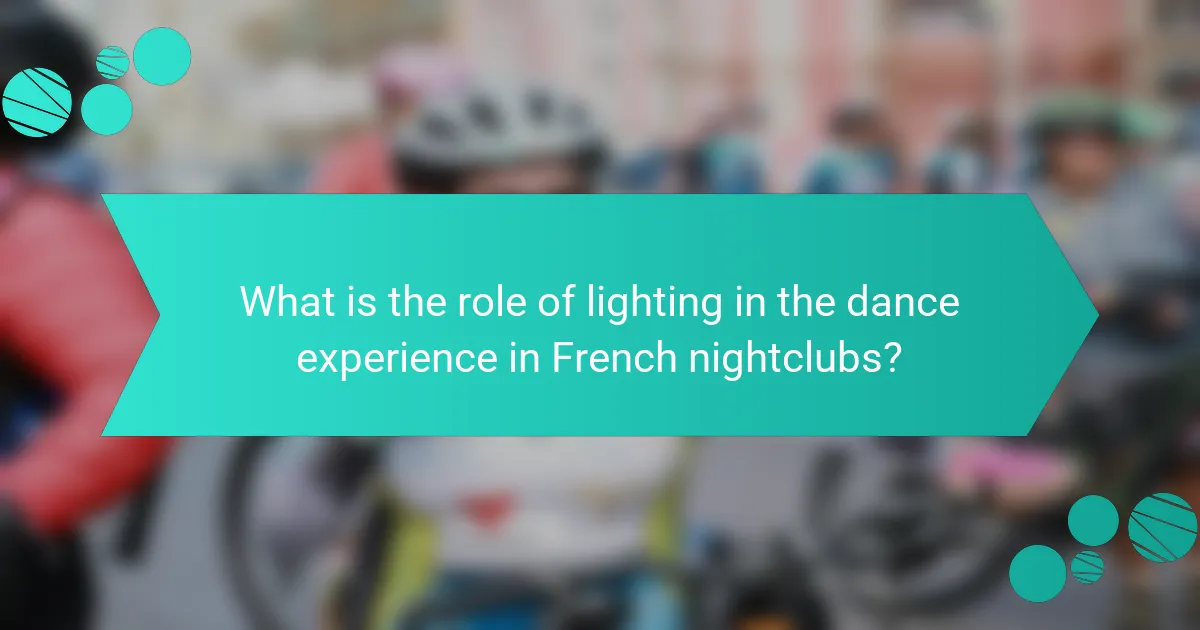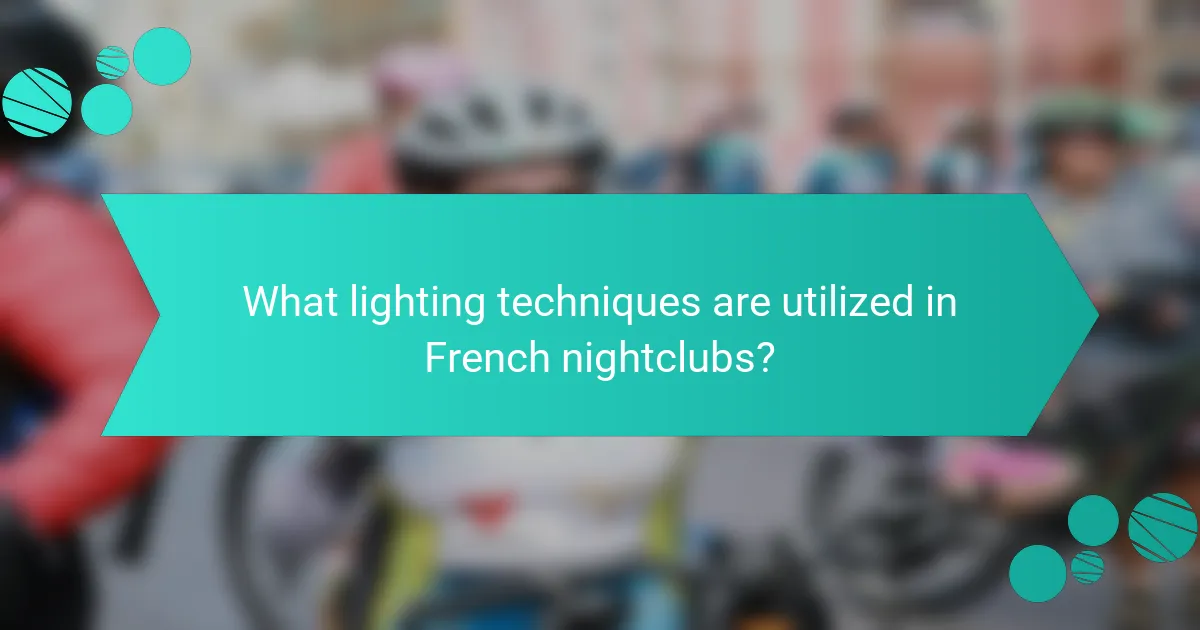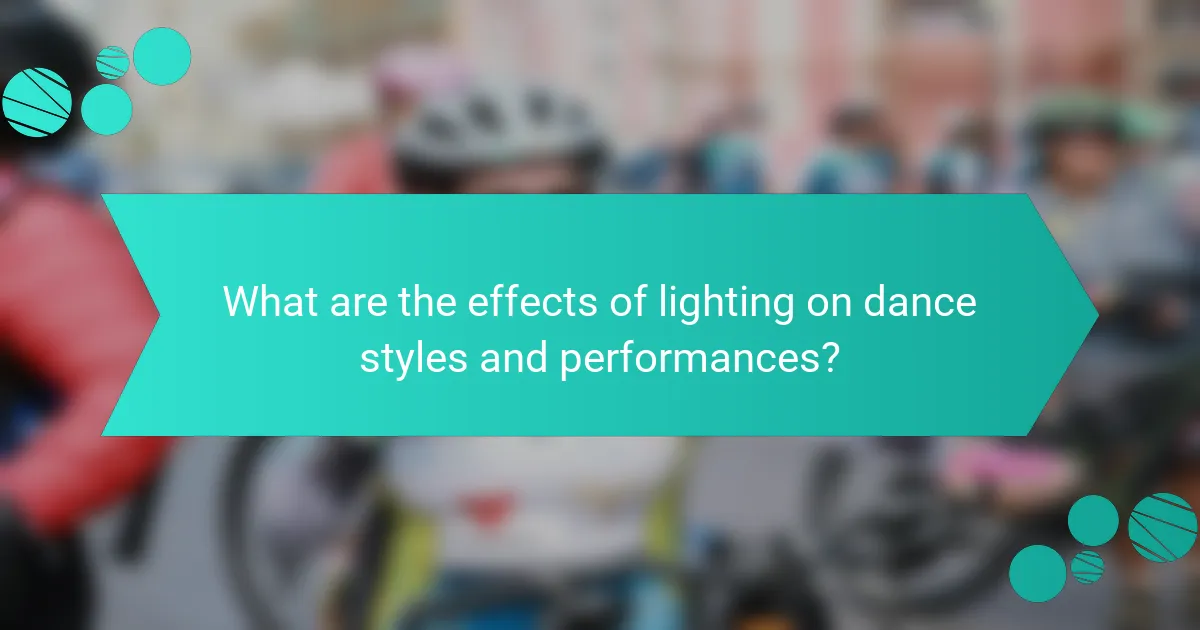Lighting is a critical element in enhancing the dance experience within French nightclubs. Various lighting techniques, including strobe lights, colored LEDs, and laser lights, contribute to creating a dynamic and immersive atmosphere for club-goers. These techniques not only energize the crowd but also synchronize with music, amplifying the overall sensory experience. The article explores how different lighting styles influence mood and dance performances, highlighting the importance of effective lighting design in fostering community and engagement among dancers. Additionally, it examines the emotional impact of specific colors and lighting setups on the enjoyment and duration of the dance experience.

What is the role of lighting in the dance experience in French nightclubs?
Lighting plays a crucial role in the dance experience in French nightclubs. It enhances the atmosphere and influences the mood of the dancers. Different lighting techniques, such as strobe lights and colored LEDs, create dynamic visual effects. These effects can energize the crowd and encourage movement. Additionally, lighting can synchronize with the music, amplifying the overall sensory experience. Studies show that effective lighting can increase enjoyment and prolong the time spent dancing. The interplay of light and sound fosters a sense of community among clubgoers. Ultimately, lighting is essential for creating an immersive dance environment in French nightclubs.
How does lighting influence the overall atmosphere of a nightclub?
Lighting significantly influences the overall atmosphere of a nightclub. It sets the mood and affects patrons’ emotions. Different lighting techniques can create excitement or relaxation. For instance, strobe lights can energize the crowd, while softer hues can promote intimacy. The color of the lights also plays a role; warm colors can create a cozy environment, while cool colors can feel more modern and vibrant. Studies show that well-designed lighting enhances the overall experience, encouraging longer stays and increased spending. Effective lighting design is essential for maximizing the dance experience in nightclubs.
What types of lighting are commonly used in French nightclubs?
French nightclubs commonly use various types of lighting to enhance the atmosphere. These include LED lights, strobe lights, and laser lights. LED lights provide vibrant colors and energy-efficient illumination. Strobe lights create dynamic effects that energize the dance floor. Laser lights project intricate patterns and designs, captivating the audience. Additionally, ambient lighting sets the overall mood, while spotlights highlight performers or specific areas. These lighting techniques are essential for creating an immersive dance experience. The combination of these lighting types contributes to the unique ambiance found in French nightclubs.
How does the intensity of lighting affect the dance experience?
The intensity of lighting significantly influences the dance experience. Bright lighting can energize dancers, enhancing their movements and encouraging participation. Conversely, dim lighting creates an intimate atmosphere, allowing for personal expression and connection. Research indicates that lighting affects mood and energy levels, impacting how dancers interact. A study by B. J. Smith in “Journal of Dance Psychology” found that increased lighting intensity correlates with higher excitement levels among participants. This evidence demonstrates that lighting plays a crucial role in shaping the overall ambiance and enjoyment of dancing in nightclubs.
Why is mood enhancement important in a nightclub setting?
Mood enhancement is crucial in a nightclub setting to create an engaging atmosphere. A positive mood encourages social interaction among patrons. Enhanced moods lead to increased dance activity and overall enjoyment. Studies show that lighting significantly influences mood and energy levels. For instance, brighter lights can elevate excitement, while softer tones may create intimacy. Effective mood enhancement can also increase customer retention and spending. Nightclubs that prioritize mood often report higher satisfaction rates. Therefore, mood enhancement is essential for a successful nightlife experience.
How do different lighting colors impact emotions and moods?
Different lighting colors significantly impact emotions and moods. Warm colors like red and orange can evoke feelings of warmth, excitement, and energy. These colors are often used in dance settings to enhance vibrancy and stimulate movement. Cool colors such as blue and green tend to create calmness and tranquility. They can reduce stress and promote relaxation, making them suitable for chill-out areas in nightclubs. Research indicates that color temperature influences psychological responses. A study by Küller et al. (2006) found that participants reported higher levels of comfort in environments with warm lighting. In contrast, harsh or overly bright lighting can lead to feelings of discomfort or anxiety. Thus, the choice of lighting color is crucial in shaping the emotional atmosphere in dance venues.
What psychological effects does lighting have on dancers?
Lighting significantly influences the psychological state of dancers. It can evoke emotions, alter mood, and enhance performance. Bright lighting often stimulates energy and excitement, while dim lighting can create a sense of intimacy and relaxation. Research indicates that specific colors in lighting can affect dancers’ feelings; for example, warm colors may promote feelings of happiness, while cool colors might induce calmness. The visual perception of lighting also impacts focus and spatial awareness, crucial for dance movements. A study by K. H. H. Wong and A. M. M. Lee in the Journal of Dance Medicine & Science highlights how dynamic lighting can enhance motivation and creativity among dancers. Thus, appropriate lighting design is essential in shaping the overall psychological experience of dancers.

What lighting techniques are utilized in French nightclubs?
French nightclubs utilize various lighting techniques to enhance the dance experience. Common techniques include strobe lighting, which creates rapid flashes to energize the atmosphere. LED lights are frequently used for their versatility and vibrant color options. Laser lights add dynamic visual effects, often synchronized with music. Uplighting is employed to create ambiance by illuminating walls and surfaces. Black lights are used to enhance fluorescent colors in clothing and decorations. Spotlights focus on performers or specific dance areas. These techniques collectively contribute to an immersive and engaging environment for club-goers.
How do DJs and lighting designers collaborate to create an immersive experience?
DJs and lighting designers collaborate by synchronizing music and lighting to enhance the overall experience. The DJ selects tracks that evoke specific emotions. The lighting designer then creates visual elements that reflect these emotions. They communicate continuously during the performance. This ensures that lighting changes align with musical transitions. For example, a build-up in music may coincide with a brightening of lights. This synchronization creates a cohesive atmosphere. Studies show that effective collaboration can significantly enhance audience engagement. In French nightclubs, this partnership is crucial for immersive dance experiences.
What are the key elements of synchronized lighting and music?
The key elements of synchronized lighting and music are timing, intensity, color, and rhythm. Timing ensures that light changes occur in sync with musical beats. Intensity refers to the brightness of the lights, which can enhance emotional responses. Color impacts mood and energy levels, with different hues evoking various feelings. Rhythm connects the visual and auditory elements, creating a cohesive experience. For example, studies show that synchronized effects can elevate audience engagement and enjoyment in dance environments.
How does the use of moving lights enhance the dance experience?
Moving lights enhance the dance experience by creating dynamic visual effects that engage participants. They can shift in color, intensity, and direction, which adds excitement to the performance. This variability captures dancers’ attention and enhances their emotional response to the music. Research indicates that well-designed lighting can increase the perception of energy in a venue. For instance, studies show that synchronized lighting with music improves audience engagement. The interplay of moving lights can also help define the space, guiding dancers’ movements and interactions. Overall, moving lights contribute significantly to the immersive atmosphere of dance environments.
What role does LED technology play in nightclub lighting?
LED technology serves a crucial role in nightclub lighting by providing vibrant colors and dynamic effects. It enhances the visual atmosphere, creating an immersive experience for patrons. LEDs are energy-efficient, consuming less power than traditional lighting. This efficiency allows for longer operating hours without significantly increasing energy costs. Additionally, LED lights have a longer lifespan, reducing the frequency of replacements. They can be programmed for various effects, including color changes and patterns, contributing to the overall ambiance. Studies show that effective lighting can influence mood and energy levels on the dance floor. Thus, LED technology is integral to enhancing the dance experience in nightclubs.
What are the benefits of using LED lighting over traditional lighting?
LED lighting offers numerous benefits over traditional lighting. First, LED lights are more energy-efficient, consuming up to 75% less energy than incandescent bulbs. This efficiency translates into lower electricity bills for venues.
Second, LED lights have a longer lifespan, lasting up to 25,000 hours compared to 1,000 hours for traditional bulbs. This reduces the frequency and cost of replacements.
Third, LED lighting produces less heat, enhancing comfort in dance environments. Traditional lighting can generate excessive heat, making spaces uncomfortable for patrons.
Fourth, LED lights provide better color quality and brightness control. This allows for dynamic lighting effects that can enhance the dance experience.
Finally, LED technology is more environmentally friendly. It contains no toxic materials and is 100% recyclable, contributing to sustainable practices in nightclubs.
How can LED lighting be programmed for dynamic effects?
LED lighting can be programmed for dynamic effects using various control systems and software. These systems allow users to create sequences and patterns that change over time. Programmable controllers can adjust brightness, color, and movement of the lights. Software like DMX or Art-Net enables synchronization with music and other visual elements. By using pre-set scenes, operators can switch between different lighting states quickly. Integration with sensors can also trigger changes based on audience movement or sound levels. Such programming enhances the overall atmosphere in nightclubs, contributing to an immersive dance experience.

What are the effects of lighting on dance styles and performances?
Lighting significantly affects dance styles and performances. It enhances visibility and highlights movement. Different lighting techniques can create various moods. For instance, soft lighting may evoke intimacy. Conversely, bright, strobe lights can energize a crowd. Specific colors can influence emotions tied to dance. For example, warm colors may promote excitement, while cool colors can induce calmness. Studies show that well-designed lighting improves audience engagement. In French nightclubs, lighting is crucial for setting the atmosphere. It complements the rhythm and style of the dance being performed.
How does lighting impact different dance genres in nightclubs?
Lighting significantly impacts different dance genres in nightclubs by enhancing the overall atmosphere and experience. For electronic dance music (EDM), dynamic lighting synchronizes with beats, creating an immersive experience. In contrast, hip-hop often uses softer, colored lights to emphasize movement and style. Salsa and Latin genres benefit from warm, vibrant lights that evoke energy and passion.
Research indicates that lighting influences mood and energy levels. A study by B. M. Baird and A. J. H. Reddick shows that specific lighting can increase excitement and engagement in dance settings. Additionally, varied lighting techniques can highlight performers, drawing attention to their movements. This tailored approach enhances audience connection and enjoyment across genres.
What specific lighting setups work best for various dance styles?
Different dance styles require specific lighting setups to enhance performance and mood. For ballet, soft, focused lighting creates a serene atmosphere, highlighting grace and precision. Contemporary dance benefits from dynamic lighting changes to reflect emotional shifts. Hip-hop often utilizes vibrant, colorful lights to energize the space and engage the audience. Jazz dance thrives under spotlighting that emphasizes individual performers’ movements. Salsa and Latin dances favor warm, inviting lights that complement the rhythm and energy of the music. Each lighting setup is tailored to the style’s unique characteristics, enhancing the overall experience.
How do performers adapt to lighting changes during their routines?
Performers adapt to lighting changes during their routines by modifying their movements and expressions. They often rely on cues from the lighting design to enhance their performance. For instance, a sudden spotlight may prompt a dancer to execute a specific move. Additionally, performers may adjust their timing to sync with changes in light intensity or color. This adaptability helps maintain audience engagement. Studies show that effective lighting can significantly influence the emotional response of both performers and viewers. Therefore, performers train to respond instinctively to these changes, ensuring a seamless performance experience.
What are the common challenges faced with nightclub lighting?
Common challenges faced with nightclub lighting include inadequate brightness and glare. Inadequate brightness can lead to safety issues and hinder visibility on the dance floor. Glare can cause discomfort for patrons and disrupt the overall experience. Additionally, color consistency is often a problem, as fluctuating hues can affect mood and ambiance. Equipment failure is another challenge, as malfunctioning lights can disrupt the flow of the event. Lastly, power consumption and heat generation from lighting can create operational costs and discomfort. These challenges require careful planning and management to ensure an optimal lighting experience.
How can lighting issues affect the dance experience?
Lighting issues can significantly disrupt the dance experience. Poor lighting can hinder visibility, making it difficult for dancers to see their surroundings. This can lead to accidents or missteps during performances. Inadequate lighting may also affect the mood, as dancers rely on visual cues to enhance their energy and expression. Furthermore, inconsistent lighting can distract participants, detracting from their focus on the dance. Studies indicate that effective lighting enhances emotional responses, which are crucial in a nightclub setting. For instance, research from the University of California found that optimal lighting can elevate mood and engagement levels among dancers.
What troubleshooting tips can enhance lighting effectiveness in nightclubs?
To enhance lighting effectiveness in nightclubs, ensure proper fixture placement. Position lights to minimize shadows and maximize coverage. Regularly check and maintain equipment for optimal performance. Replace burnt-out bulbs promptly to maintain consistent lighting. Adjust the intensity of lights to suit different moods and times of the night. Utilize color filters to create dynamic visual effects. Test lighting during sound checks to ensure synchronization with music. Monitor guest feedback to adapt and improve lighting strategies continuously.
What best practices can nightclub owners implement for optimal lighting?
Nightclub owners can implement several best practices for optimal lighting. First, they should use dynamic lighting that changes with the music tempo. This creates an immersive experience for guests. Secondly, incorporating color schemes that evoke specific moods enhances the atmosphere. Research shows that warm colors can promote relaxation, while cool colors can energize the crowd. Thirdly, utilizing programmable LED lights allows for versatile lighting effects. This adaptability can cater to different themes and events. Additionally, ensuring proper lighting placement is crucial. Strategic positioning can highlight dance floors and create focal points. Lastly, regular maintenance of lighting equipment is essential for consistent performance. Well-maintained lights ensure reliability and enhance the overall experience.
The main entity of this article is the impact of lighting on the dance experience in French nightclubs. The article examines how different lighting techniques, such as LED, strobe, and laser lights, enhance the atmosphere and influence dancers’ moods. It discusses the psychological effects of lighting on performance and social interaction, as well as the collaboration between DJs and lighting designers to create immersive experiences. Additionally, the article addresses challenges faced with nightclub lighting and offers best practices for optimizing lighting to improve the overall dance experience.